Muscular injuries in your dog.
Massage therapy to rehabilitate muscular injures can have a profound effect.
There are 700 muscles in a dog’s body accounting for 45% of its weight and these muscles can pick up muscular injuries from normal activities of daily living such as jumping on and off the furniture, pulling on the lead or normal play activities like ball chasing or running. Anyone who has suffered from muscular pain in the neck or back, for example, understands exactly how debilitating this can be.
Dogs are pack animals that are very adept at hiding pain so spotting when your dog has a problem is not always that easy. Some of the things to look for include:
Gait
Changes in gait can be indicative of a soft tissue injury. Analysing the way a dog walks, trots and canters can identify areas of pain, soreness and stiffness. Gait irregularities such as pacing, limping and knuckling over can be indicative of areas of the musculo skeletal system not functioning correctly.
Posture
Observing a dog’s posture from different angles can highlight issues. It is possible to determine areas of the body that are under strain and thereby understand which muscles are causing it.
Changes from the norm
Change in the normal activities of daily life – struggling to get on and off the sofa, unwillingness to be touched, withdrawing from the family, slowing down on walks or not walking so far as usual can all be indications of deeper underlying issues.
Behaviour
More and more research is taking place into the correlation between pain and behavioural problems. Wide radiating myofascial pain across the Latissimus Dorsi can, for example, cause a dog so much discomfort that they are likely to growl or snap when touched in that area.
Performance
In competition, knocking poles, reluctance to weave or coming out of weaves too early, knocking down jumps, missing contact points, being slower than usual can be signs of soft tissue injury.
When carried out by a trained professional massage benefits the muscular system in the following ways:
- The stretching and relaxing of the muscle promotes flexibility
- Toxic waste products such as lactic acid are eliminated
- There is a reduction of scar tissue formation through working into the muscle
- Improved muscle tone
- Better posture
- Massage therapy dilates blood vessels restoring the flow of oxygen and nutrients to the injured area.
